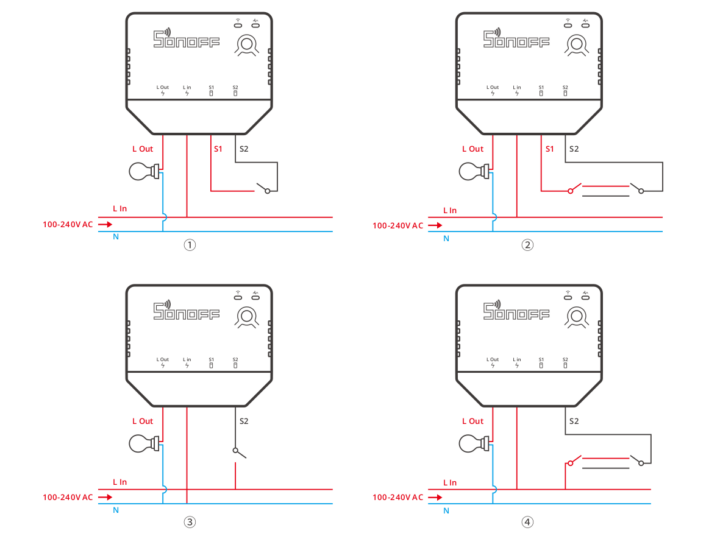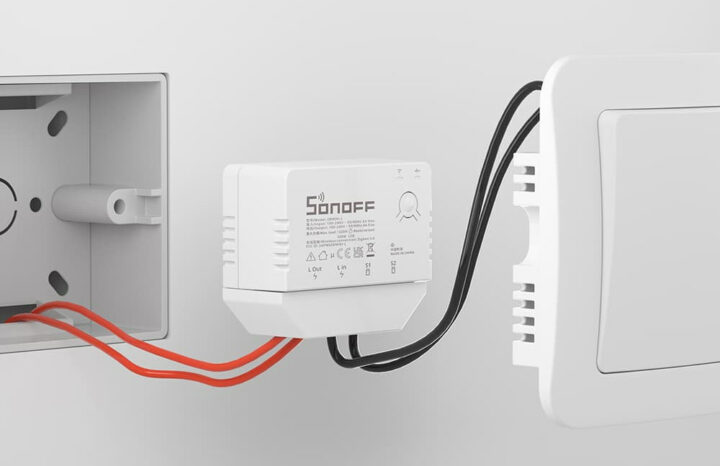When using a wireless switch like SONOFF T2 a connection to the neutral wire is needed to power the device, but this is not always feasible/practical as many lights as cabled without a neutral wire.
SONOFF ZBMINI-L Zigbee 3.0 smart switch solves this issue as it does not require a neutral wire. Simply connect the two wires for the light and you are good to go. ITEAD says its solution does not require an extra anti-flicker module and relies on an “advanced electricity extraction technique”.
SONOFF ZBMINI-L specifications:
- Connectivity – Zigbee 3.0 via TI CC2652P, up to 50 meter range (line of sight)
- Input – 100-240V 50/60Hz up to 6A
- Output – 100-240V 50/60Hz up to 6A
- Max. Load
- Resistive – 1380W Max @ 230V, 720W Max @ 120V
- LED – 300W Max @ 230V, 150W Max @ 120V
- Dimensions – 54 x 45 x 24mm (supports 35mm DIN Rail mounting)
- Enclosure material – PC V0
- Temperature Range – -10°C to +40°C
- Certifications – FCC, CE; TÜV safety certification

It’s nice to see a SONOFF switch getting TUV safety certification and it should alleviate concerns some had with previous SONOFF products notably with regards to insurance, besides safety. The company says the switch works LED lights that draw as little as 3W without flickering, so I just draw enough current to power itself at all times without turning on the light unless instructed by the user.
ZBMINI-L is compatible with SONOFF ZBBridge and SONOFF Zigbee Dongle Plus, as well as Amazon Hub, Samsung Hub, and other Zigbee 3.0 compatible home hubs. You may also automate lighting with motion or windows/door sensors like SNZB-01, SNZB-02, SNZB-03, SNZB-04, or compatible Zigbee devices from third parties.
SONOFF ZBMINI-L works with the eWelink app for Android and iOS, and supports Google Assitant, Amazon Alexa, Yandex Alice, and Samsung SmartThings. There seem to be two features that I had not seen before with Web Control to control devices from a web browser and eWelink keyboard to turn on/off the lights with a keyboard shortcut from your computer or laptop. IFTTT is also available, but only with the (paid-for) Advanced membership for the eWelink app.
ITEAD has produced the first batch of 1,000 pieces with the unit sold for $13.40 directly in their store. For additional information, you may want to check out the user manual and quick start guide.

Jean-Luc started CNX Software in 2010 as a part-time endeavor, before quitting his job as a software engineering manager, and starting to write daily news, and reviews full time later in 2011.
Support CNX Software! Donate via cryptocurrencies, become a Patron on Patreon, or purchase goods on Amazon or Aliexpress. We also use affiliate links in articles to earn commissions if you make a purchase after clicking on those links.





TÜV isn’t a safety certification in the same way as a UL certification though, as it’s not required by any nation, it just means that the product isn’t likely to malfunction in such a way that the user takes damage or their house burns down in this specific case. Without UL certification, this product is still not legal to use in the US.
That’s not correct at all. TUV does safety certification; it’s basically the German equivalent of UL, and is a NRTL, so TUV certified products certainly are legal to use in the US.
https://www.tuvsud.com/en/services/product-certification/nationally-recognized-testing-laboratories
As pointed out by Jon, TÜV does a lot of certification and although they’re also the German equivalent of UL, they do food safety testing and a bunch of other things, so you can pay them to test whatever you want. UL only tests for electrical safety. Also, Germany doesn’t require TÜV testing by law, as CE certification is the only legally required certification in the EU. TÜV is considered a superior labelling, but you need to know the specifics of what was tested for it to be relevant or not.
We need to know which standard Sonoff had TUV test to. This is BS if they had TUV certify them for ROHS and then market it as a ‘safety’ rating.
Give us a link to the TUV testing file for the product.
I’m hoping they did test to an electrical safety standard. If they start doing that I will buy some of their product. I will also point out that the Sonoff office in Shenzhen is a few blocks away from the ETL testing office in Shenzhen, and AFAIK Sonoff has never made a visit to ETL. ETL tests to the UL electrical safety standards. Since lack of certification has been going on for years I have to wonder if they are unable to pass.
UL does a lot of certification, too, not just electrical safety, so in any case it’s good to check what the device was certified to (a proper CE document should list these).
My Sonoff S31 smart plugs are listed as ETL certified.
> as CE certification is the only legally required certification in the EU
A CE certification doesn’t even exist and isn’t of any importance for the consumers.
CE is a (self)declaration to comply with EU rules, that’s it. Nothing else. Beside the symbol isn’t even for consumers!
And for the TüV, they typically do anything for you if you pay for it. They might do certifications for iso stuff or your bridge… which sometimes falls apart after it was certified successfully.
I remember that the TüV also had some “safer shopping” types certificates for online shops which were.. how to call it… A big joke. The online shops “certificated” by TüV and bugs which allowed people to access bills from other customers and more.
In Germany they say the internet is Neuland.
UL1472 is a fire and shock safety standard. These things have a lot of current in them and they run 24/7. You don’t want them starting fires.
You also don’t want them failing in a way that puts AC onto a surface humans can touch. One UL test that companies fail is high humidity. In high humidity water condenses inside the unit and AC flows through the water onto unintended surfaces. This is easy to fix by having the proper amount of clearance around the AC carrying wires. But you have to be aware of this to know that it needs to be fixed.
So it is true safety certifications are not legally required. But there is also a string of dozens of destroyed houses caused by hoverboards that were not UL tested which burn down those houses. Now that no one will sell a non-UL tested hoverboard the fires have stopped.
Go look at dimmers/switches for sale. Every single one from a major brand is UL/ETL safety tested. Only the minor brands avoid testing.
I’m aware that the UL certifications are “real” and that *some* of them are obligatory to legally sell stuff in US/CA.
On the other the EU doesn’t have something like the UL. Actually their is not obligatory certificate to sell stuff in EU countries.
It’s a common misunderstanding that the “CE” sign is something similar. It’s simply not, it’s a (self)declaration of the producer which doesn’t need an 3rd part involved (kind of the opposite of a certification).
And for the TüV, they check anything (iso, din, whatever standards) if you pay them. That’s essentially it.
The important question, which safety specification was this tested to? Is there a specific TUV spec for smart dimmer/switch like UL has? UL1472 is dimmers
There are all kinds of safety specs — does not contain hazardous materials, small object infant can swallow, etc, etc.
Yeah, that was kind of my point.
The manual (currently Chinese only) lists a number of agencies under “认证 ” (certifications) — TUV/CE/FCC/UKCA/RoHS.
It does not list which tests. That isn’t uncommon though is it? Many products sold in the US and Canada simply list UL or CSA (often both) on them. In a manual the only common thing one might see us the FCC radio interference compliance warning I think.
How much energy does it consume in stand by? I know that some this no neutral wire devices consume up to 10W!
10W would be huge because it would release a high current into the idle device. The text mentions 3W which isn’t negligible either.
The text indicates that placing the device inline will not cause a 3W lamp to activate, so the current flow is likely to be below that.
Ah indeed I misunderstood that part.
I suspect it employs two power supplies, one high-voltage low-current when the device is off, so as to extract the juice without causing flickering, and a low-voltage one that’s made of a current transformer in series with the powered device, that converts a very low voltage drop into a high-enough voltage to work. It’s possible that it has a minimal supported load to work fine. E.g. trying to control a 10W LED strip might possibly not work well.
I think there’s also a possibility to extract some of the alternating voltage that passes through the saturated triac (1-2V p-p) but the problem is that this would something with a lower drop to steal the losses it and would defeat the principle (i.e. if this can be done, the component used to do it could replace the triac).
Regardless of the employed method, what matters is that it’s easier to deploy for the user 🙂
Example reference design for 2-wire dimmer
https://www.st.com/en/evaluation-tools/steval-ild004v1.html
They work by constantly leaking current through the load. Works great for incandescent bulbs. LED bulbs more tricky. You have to design the dimmer to use very small amounts of power while it is in off mode since LEDs will only leak a few milliamps.
Yes and in addition, even with tiny currents they can be visible at night. I have a LED strip in my bedroom which lights by itself when it’s rainy outside, because the wall is a bit moister, and a little bit of current leaks from the power supply to the wall. At night I can see 3-4 LEDs slightly lit in this case. There are likely no more than a few tens to hundred of microamps but it’s sufficient.
Do you have any idea if it will work with the Philips HUE Bridge (Zigbee 3.0 Light)?
Yes I have tested it and it works great.
Here’s a Youtube video
and review on my blog.
Strange that they did not make neutral wire optional for those who have it. It would be best to use neutral if it is there.
They have the ZBMINI for that configuration. It is designed to provide switched L/N to a lamp from an L/N supply. It is also a lot cheaper.
details and information